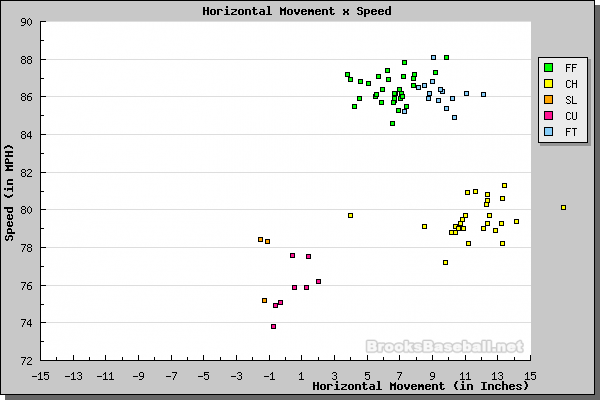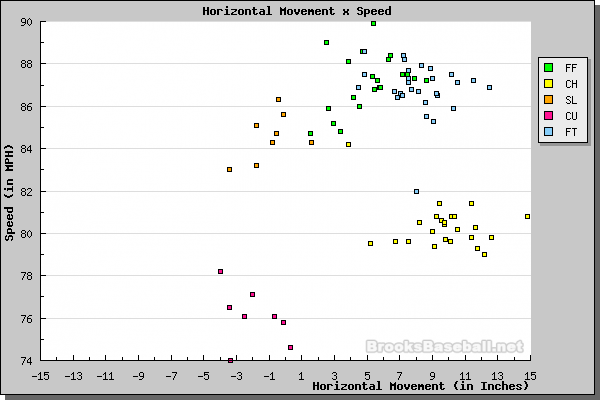Jason Vargas’ New Pitch
In his post-game conversation with Geoff Baker, Jason Vargas noted that he started throwing a cutter last night, after shelving it last year to work on his breaking ball. Over the last few years, we’ve heard a lot of stories about Mariner pitchers making changes to their mechanics (remember Miguel Batista’s eureka moment?) or adding a new pitch to their repertoire (hello, Dolphin), but it usually has amounted to a big ball of nothing.
This might be different.
Below are two graphs from Brooks Baseball, showing Vargas’ pitch selection in his first start against Texas and then last night’s performance against the A’s. 

As you can see in the first graph, he was a three pitch guy in Texas – fastball, curveball, change-up. Last night, however, you see a new blob of pitches, the one between 83-86 MPH with negative horizontal movement. The Pitch F/x algorithm calls it a slider, but that’s pretty normal; it’s tough for the system to distinguish between a cut fastball and a slider in a lot of cases.
He only threw 8 of these cut fastballs, but all eight were strikes, and he mostly worked them in when the count was even. Rather than having to go to his hit-me fastball on a 1-1 pitch, Vargas was able to use his cutter to get ahead in the count, at which point he could then throw a fastball out of the zone or a change-up to get a strikeout. Adding a pitch he can throw for strikes to keep himself in pitchers counts can do wonders for him, since he doesn’t have the dominating stuff to constantly pound the zone and get away with it.
Now, don’t go getting too carried away with this. It’s just eight pitches in one start, and it was the A’s offense in Safeco Field, so we’ll have to see how confident he is throwing at a good offense in a hitters park, but adding a cut fastball to his repertoire could be a significant boost for Vargas. It’s certainly something worth keeping an eye on, and if he gains confidence in the pitch, he may be able to perform better than expected.

This is why I was okay with a bushell of #5 starters. When you look at all the guys filling out the back of the M’s rotation, they all have flaws that limit their effectiveness, but they all also have the potential to take some sort of step forward and become, not a Felix or Lee, but a solid +2 WAR guy. The odds of any one of them doing that is small, but get enough of them and you’ve got a decent chance to find a minor gem.
I like the optimism Dave.I hope this does translate into Vargas being a regular in the rotation but we saw him do well to start off last year too. I just hope he can hold on to it.
Vargas never pitched this well last year. His best two start stretch was May 22nd/29th, against San Francisco and the Dodgers. He threw 13 1/3 innings, walked three, struck out nine, and had a five percent swinging strike rate. In the second of those two games, he was pitching in an NL park, so there was no designated hitter.
This year, he’s walked one and struck out 11 in 11 1/3 innings and has an 11 percent swinging strike rate. It’s all small sample theatre, but these first two starts are better than any two starts he had last year.
Hey guys, I’m new to Pitch F/x and was just wondering about how to read this plot. Should I be looking at this from the batter’s perspective or the pitcher’s? Or should I say, are the negative numbers on the x-axis representing the right or left side of the plate?
What I truely love about this, we are finally developing our own pitchers. Instead of whatching gritty Vets that just can’t pitch anymore. Getting younger guys willing to fight there way onto a team. Instead of expect it.
The pitch f/x graphs are from the catcher’s perspective. A positive value in horizontal movement is to the catcher’s right, while a negative value is to the catcher’s left.
Essentially, this graph is showing that Vargas’ cut fastball moves in on right-handed hitters (and away from left-handed hitters) more than his normal fastball.
Terrific look. Thanks, Dave.
If you were to do a similar look at Doug Fister, would it show anything interesting?
Not really, no. He just threw a ton of fastballs, and the A’s hitters didn’t do anything with them.
Very interesting. I like the fact that these clusters are fairly tight and well defined. It suggests to me he is able to repeat these pitches consistently and with good control.
It also looks like his curve had more break to it last night. Maybe that helped him with the shut out.
Keep it up J!
Have to look at the release point graphs for the two games to tell for sure (maybe the vert movement chart too), but it looks like he was throwing his curveball a little more to the side, a 1-7 motion rather than a 12-6.
I only watched a couple of innings, but it appeared Vargas was getting hitters to chase the curve down low. If he was able to throw more low curves than usual, that could explain a spike in break. Lower release point on an overhand curve = more leverage = more rotations = more break.
Well, actually looking at the plots, he was just getting more movement, both vertical and horzontal, on his curve. It dropped more and moved away from LHH more.
Try not to read too much into minor differences in break diagrams from two starts. The Pitch F/x system in Texas is a little weird, suppressing velocity and making cross-ballpark comparisons a little sketchy.
We can say definitively that Vargas was throwing a pitch last night that he did not throw in Texas. We can’t really say much about how his pitches moved relative to each other between games.
There was a great article that was about how Tim Wakefields 72mph fastball is an effective pitch (I can’t find it now!) Same principle here…. Along a parallel, has Fister started to mix in a 4-seamer or cutter to compliment his sinker? Last year he seemed to only throw sinkers, change-ups and a curve. Shawn Kelley also is rediscoverig his change-up. How many guys have shelved servicable pitches?…………Great stuff dave (sorry about similar comment, I should’ve refreshed and read. not write).
This is great, it seemed to me that Doug Fister
gained some confidence, belief, and attitude as the game progressed!
This is interesting… I would love to see one of Brandon League’s 2 innings.
Brandon League.
Wow! That is a wicked fastball. How much control could you possibly have on something that moves that much?!
That’s the paradox that is Brandon League – stuff so nasty that he probably can’t command it every night.
Wow, that whole graph of League’s is a cluster of outliers! 🙂
Yes, although it tends to be overlooked, League is as much of a freak on this team as Gutierrez, Ichiro, and Felix. As Blengino noted, and as Matthew Carruth described, League last year had the toughest pitch to hit in baseball.
Maybe I missed it, but what happened to his goggles?
I think the broadcast said that he was wearing contacts last night. They didn’t give a reason that I heard.
From Geoff Baker
So Jays caps and M’s caps have different shapes? That’s weird — I thought they were all a standardized New Era design with variation in color and logo only.
I would’ve thought that eyewear for a pitcher is sensitive enough that if there was an incompatibility you’d end up with a custom cap, not a change to contact lenses. Afterall, I assume he tried contact lenses early on and went with the goggles instead for good reason. How does RRS manage? Different-shaped head?
But I’m just annoyed because I loved that Mr Magoo mien — I think it always adds a little intimidation when a guy who throws as hard as League looks like he has trouble even seeing what he’s aiming at.
I’ve been wondering about Brandon League’s seeming aversion to throwing his splitter so far this season. What’s amazing about League is that the movement Dave and Joser are talking about is on his fastball, but the pitch that everyone got excited about in the offseason was his splitter, which had insane vertical break. This means he has at least two awesome pitches, moving in very different ways.
In the chart Dave linked to, it appears League threw two off-speed pitches, but neither had much negative horizontal break. Is this a different pitch, or has League not been able to reproduce the pitch that was so dominant last season?
Alternatively (partly in jest), is Rob Johnson just afraid he won’t be able to catch the splitter if he calls for it?
Brandon League can be the man. What does his release points look like? Last night he did something different with his hands every pitch. Sometimes he would raise them silmultaneously with his leg lift. Sometimes he would just pull the ball out, a slide-step move, but no one was on. Love the potential and we haven’t seen the ‘best pitch in baseball’ very much.
Thanks for the reminder Dave, it’s easy to get carried away with how amazingly cool it is to look through the pitch F/x data.
The other valuable thing about having something other than the change-up that he can throw for strikes: the change-up tends to bury itself in the dirt, which can make things… interesting when Rob Johnson is your catcher, and disastrous if there are men on base.